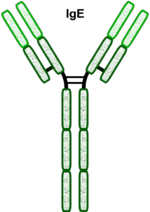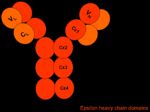Difference between revisions of "Immunoglobulin E"
Jump to navigation
Jump to search
| (18 intermediate revisions by 4 users not shown) | |||
| Line 1: | Line 1: | ||
| − | {{ | + | {{review}} |
| − | + | <p>Commonly referred to as ''''''IgE</p> | |
| − | [[Image:LH IgE.png|thumb| | + | [[Image:LH IgE.png|thumb|150px|right|'''IgE''']] |
| − | [[Image:IgE.jpg|thumb|right| | + | [[Image:IgE.jpg|thumb|right|150px|IgE - B. Catchpole, RVC 2008]] |
| − | + | <p>Unlike [[IgM]], [[IgG]] and [[IgA]], IgE does not function as a soluble antibody and is found in low levels in blood plasma. Like [[IgA]] it is produced by plasma cells and is mainly localised to mucosal surfaces.</p> | |
| − | |||
| − | |||
| − | Unlike [[IgM]], [[IgG]] and [[IgA]], IgE does not function as a soluble antibody | ||
| − | |||
==Structure== | ==Structure== | ||
| − | + | <p>IgE is Y-shaped with heavy chain type ε, and exists as a monomer.</p> | |
| − | IgE is Y-shaped with heavy chain type ε, and exists as a monomer. | + | ''Note: Janeway <ref>{{citation|initiallast = Janeway|initialfirst = C.A|2last = Travers|2first = P|3last = Walport|3first = M|finallast = Shlomchik|finalfirst = M.J|year = 2005|title = Immunobiology: The immune system in health and disease|ed = 6th |city = New York|pub = Garland Science Publishing|range = 156-157}}</ref> states that IgE has no hinge region whereas Tizard <ref>{{citation|initiallast = Tizard|initialfirst = I.R|year = 2004|title = Veterinary Immunology: An Introduction|ed = 7th|city = Philadelphia|pub = Saunders|range = 148-149}}</ref> indicates that it does. |
| − | |||
| − | ''Note: Janeway <ref>{{citation|initiallast = Janeway|initialfirst = C.A|2last = Travers|2first = P|3last = Walport|3first = M|finallast = Shlomchik|finalfirst = M.J|year = 2005|title = Immunobiology: The immune system in health and disease|ed = 6th |city = New York|pub = Garland Science Publishing|range = 156-157}}</ref> states that IgE has no hinge region whereas Tizard <ref>{{citation|initiallast = Tizard|initialfirst = I.R|year = 2004|title = Veterinary Immunology: An Introduction|ed = 7th|city = Philadelphia|pub = Saunders|range = 148-149}}</ref> indicates that it does. | ||
| − | |||
==Production== | ==Production== | ||
| − | + | <p>It is produced when Th2 cells stimulate CD40 and produce Il-4 and Il-13 which causes B cell differentiation to plasma cells and class switching to IgE production.</p> | |
| − | It is produced when | ||
| − | |||
==Function== | ==Function== | ||
| − | + | <p> | |
| − | IgE triggers acute inflammation by binding to the FCεRI receptors on mast cells in the lamina propria and | + | *IgE triggers acute inflammation by binding to the FCεRI receptors on mast cells in the lamina propria and basophils, causing degranulation |
| − | + | *It is involved in type I hypersensitivity reactions | |
| + | *Cross-linking of IgE molecules by antigen triggers mast cell degranulation and an inflammatory response</p> | ||
| + | <p> | ||
| + | *IgE has considerable involvement in producing immunity to parasitic worms and particularly nematode parasites | ||
| + | **It may mediate their expulsion or killing via mast cell activity, cytotoxic eosinophils, macrophages, and so on</p> | ||
==References== | ==References== | ||
<references /> | <references /> | ||
<br> | <br> | ||
| + | ---- | ||
| + | <center><b><sup>[[Immunoglobulins|Immunoglobulins]]: [[Immunoglobulin A|Immunoglobulin A]], [[Immunoglobulin D|Immunoglobulin D]], [[Immunoglobulin E|Immunoglobulin E]], [[Immunoglobulin G|Immunoglobulin G]] & [[Immunoglobulin M|Immunoglobulin M]]</sup></b></center> | ||
| − | |||
| − | |||
| − | |||
| − | |||
| − | |||
| − | |||
| − | |||
| − | |||
| − | |||
| − | |||
| − | |||
| − | |||
| − | |||
| − | |||
| − | |||
[[Category:Immunoglobulins]] | [[Category:Immunoglobulins]] | ||
| − | [[Category: | + | [[Category:Image Review]] |
Revision as of 17:06, 22 September 2010
| This article has been peer reviewed but is awaiting expert review. If you would like to help with this, please see more information about expert reviewing. |
Commonly referred to as 'IgE
Unlike IgM, IgG and IgA, IgE does not function as a soluble antibody and is found in low levels in blood plasma. Like IgA it is produced by plasma cells and is mainly localised to mucosal surfaces.
Structure
IgE is Y-shaped with heavy chain type ε, and exists as a monomer.
Note: Janeway [1] states that IgE has no hinge region whereas Tizard [2] indicates that it does.
Production
It is produced when Th2 cells stimulate CD40 and produce Il-4 and Il-13 which causes B cell differentiation to plasma cells and class switching to IgE production.
Function
- IgE triggers acute inflammation by binding to the FCεRI receptors on mast cells in the lamina propria and basophils, causing degranulation
- It is involved in type I hypersensitivity reactions
- Cross-linking of IgE molecules by antigen triggers mast cell degranulation and an inflammatory response
- IgE has considerable involvement in producing immunity to parasitic worms and particularly nematode parasites
- It may mediate their expulsion or killing via mast cell activity, cytotoxic eosinophils, macrophages, and so on
References

